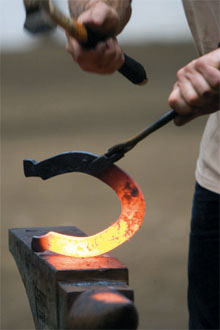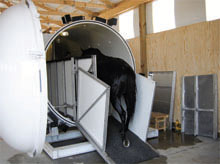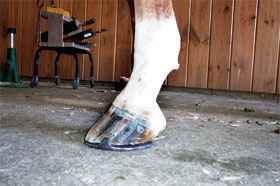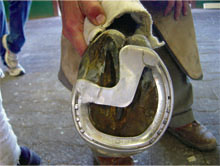After a foot or leg injury, the horse owner, veterinarian and farrier must work together as a team to facilitate the most effective way to trim, shoe and rehabilitate that horse for optimum recovery.
Careful rehabilitation therapy will often speed healing and help ensure that the horse recovers more fully, returning to its former capability as an athlete.
Scott Morrison, the veterinarian who heads the podiatry department at Rood and Riddle Equine Hospital in Lexington, Ky., says that many times, manipulation of the foot and different types of shoes can be used to help speed recovery, whether you’re dealing with an injury to the foot or farther up the leg.
Anatomy And Function
“A good understanding of the functional anatomy of the lower limb can help enable farriers to put together different shoes,” says Morrison, noting that a special shoe can help take pressure off a certain area, for instance.
Julie Bullock, a veterinary and podiatrist from Mt. Sidney, Va., says that for a deep digital flexor tendon injury, you’d usually want to raise the angle of the foot to take the pull off that tendon.

The ability of a farrier to forge special shoes or modify shoes for a particular purpose is often vital in rehabilitative hoof care following a traumantic injury.
“The farrier might start adding degree (wedge) pads,” says Bullock. “With a suspensory injury or a superficial flexor tendon injury, however, you must be careful not to raise the heel. The farrier has to know this, however.”
Farriers need to understand the anatomy of feet and legs and how the various leverage forces work.
“Just knowing what the effects of different shoe modifications may have on different structures of the lower limb is important,” says Morrison. “For instance, we know that wedging a foot up and taking strain off the deep digital flexor tendon and inferior check ligaments can be helpful when those structures are injured. Yet wedging a foot up probably puts more strain on the other structures such as the superficial flexor tendon and suspensory ligament.
“For deep digital flexor tendon injuries, we’ll do things like using small wedges or easing the breakover on a shoe to help take strain off the deep digital flexor tendon. Whereas for a suspensory ligament injury, we need to do the opposite, which is usually to trim the foot normally or sometimes make a shoe with a broader, wider toe web. But we’ll pencil (thin out) the heel branches so that the foot sinks deeper into the footing. If the heel can sink into the ground and the toe floats on the footing, this makes the horse have a functionally lower hoof angle, which puts more strain on the deep digital flexor tendon and probably takes some of the stress off the suspensory ligament and superficial flexor tendon.”
Create And Adjust Leverage
It becomes a matter of trying to create the proper leverage to reduce strain in a certain area to help the injured structure heal.
“What you do with the foot will also depend on what the horse is doing and how severe the injury is. Some horses have injuries so bad that they are not going to be moving. Those horses will be confined to strict stall rest. Some will be hand walking and some will be just walking and trotting for a long period of time before they can progress to faster work,” explains Morrison.
“How extreme or severe a shoe you make for the injured foot and leg really depends on the severity of the injury. If the horse has a mild inflammation of the deep digital flexor tendon or isn’t very lame, you won’t be putting a big wedge or heel elevation on the foot. We’re usually trying to match our therapy to the severity of the lesion. Therapeutic shoes also have a downside. Every time you manipulate a foot to take pressure off one area, you are loading something else. You are especially loading the hoof capsule (and putting more force in the heel region) when you elevate the heel to unload the deep digital flexor tendon. I hate to wedge horses up if they don’t need it because it does lead to secondary complications,” he says.
You walk a fine line, doing the least manipulation that will still do the job.
“A lot of leg injuries are due to dysfunctional feet, particularly with racehorses or any horses with low, dysfunctional heels. It’s very common to see these horses get secondary problems farther up the limb. It is important for horses to have a good strong heel. The heel area is what absorbs concussion because it contacts the ground first at high speeds. The horse will always land slightly heel first when running and it’s the heel’s job to absorb all that shock and concussion.
“It’s very common for horses that have lameness in other areas of the limb to have dysfunctional or weak, low heels. Many of those horses probably have some heel pain and will land toe first and not really utilize the heel to absorb shock and concussion. So most of those stresses go farther up the limb to adversely affect other structures,” explains Morrison.
Take Advantage Of Lay-Up Time
Some horses that are laid up for an injury already have bad feet.
“I suggest using lay-up time to try to restore the foot and get better heel function. Often the horseman is trying to get the horse to compete at a higher level and we are shoeing to enhance that athletic performance, and sometimes it’s not the best thing for the horse’s foot. If the horse will be laid up for a significant amount of time, I always take that opportunity to pull him out of those shoes and try to restore some function back into the foot,” Morrison says.

A horse enters a hyperbaric oxygen chamber during a rehabilitation session.
Just letting the horse go barefoot can often accomplish this. “This is probably the best way to rehabilitate a horse with low heels. Pull the shoes and let the foot function more normally while the horse is laid up. Often the foot will get better structure and form when allowed to be barefoot for a period of time,” he says.
This varies, with individual cases. “A lot of racehorses that come off the track, if they are going to be hand walking or walking and trotting, you can’t simply pull the shoes and let them go barefoot. Some would get too footsore because they are not used to going barefoot. Sometimes we just take them out of the racing plates and try to fit them into a more normal, wider-webbed shoe to give more support, to try to get a healthier foot under them.”
He feels it’s very important to evaluate the feet if a horse is laid up for recuperation after an injury, and see what can be done to improve them during that time period. “This is a good window of opportunity to focus on improving the health of the foot because you don’t have to worry about the horse competing. You take that factor out of the equation and do what’s best for the foot,” he explains.
Shoe Manipulations
“There are many types of shoe manipulations that can help other structures farther up the limb. If it’s a collateral ligament injury, we will widen the medial or lateral branch of the shoe to help take strain off that ligament. We can also use wedges or rolled toes for inferior check ligament injuries or deep digital tendon injuries. We can use bar shoes or create wider medial or lateral branches. We use wider toe branches for suspensory ligament injuries,” he says.
If a horse is laid up for a foot problem, many types of shoes can be used to rehabilitate that foot — whether it’s suffering from a coffin bone fracture or a bad quarter crack. “There are many shoeing prescriptions for all of these things, but the important thing to realize is that even if the horse is not laid up for a foot problem, there are a lot of things you can do via the foot to help the recovery of other structures,” says Morrison.
Teamwork Required
Bullock says that the veterinarian-farrier team is important because rehab for any kind of injury usually requires the farrier to help with the necessary trimming and shoeing prescription. “There is no specific recipe for how these things need to be done. They must be figured out on a case-by-case basis. Even hoof injuries such as avulsions often need something like a bar shoe or heart bar shoe,” she says.

In addition to knowing how to forge and modify shoes, it’s important for farriers doing rehabilitative work to understand how various shoe modifications affect anatomy and function, particularly in the lower limb. Scott Morrison, a veterinarian and farrier, notes that wedging a foot up takes strain off the deep digital flexor tendon and inferior check ligaments, but puts more strain on the superficial flexor tendon and suspensory ligament.
A half-round shoe or Natural Balance shoe can help some horses that have lesions on the proximal, interior portion of the limb. Sometimes a serious wound also requires special shoeing so the injury can heal.
“Superficial and deep flexor tendon lacerations are examples in which the shoe needs to be jacked up, and this is where farriers make a huge difference,” says Bullock. “Their ability to work with metal to for that individual horse can greatly enhance the rehabilitation. You have to be able to do something with the foot to help protect the soft tissues higher up.”
Risks For Re-Injury
With some injuries, horses need strict stall rest to avoid the stress of movement, as for a fracture or a bad tear in the soft tissue (tendon or ligament). How soon the horse can start using the limb again will depend on the injury. Care must be taken to avoid excessive stress or movement that might disrupt healing. Yet the horse needs to start moving again as soon as possible, so you walk a fine line on determining when and how much, to begin the rehab process.
“If the horse is able to walk, I try to have them keep moving if possible — unless it’s contraindicated by that particular lesion,” says Morrison. “I try to have them hand walking as much as possible. It is important to keep them moving to some degree if you can.”
How quickly the horse can go back to work will depend on the injury. It’s also important not to rush a horse back into competition too soon.
“Bringing them back is the tricky part after the lesion is healed,” Morrison says. Horses often suffer re-injury — sometimes with the same lesion reoccurring or an injury to another area — because the rest of their body is no longer fit, due to the time off and lack of activity.
Morrison says suspensory ligament injuries during the rehabilitation and recovery period are very common.
“The suspensory ligament is a structure that atrophies when not in use. The strength of that structure changes very quickly and it becomes weak,” he explains. He adds that horse owners and trainers must take care to ensure this ligament is not injured when horses go back to work. He advises bringing horses back very slowly and carefully.

Farriers and hoof care can play an important role in the rehabilitation of horses that have suffered non-hoof or foot injuries. Farriers can be called on to trim and shoe horses in ways that help protect damaged soft tissues higher up in the limb, or in situations such as when superficial or deep digital flexor tendons are lacerated. A farrier’s ability to shape metal is invaluable in rehab cases.
Complementary Therapies
Rehabilitation of many injuries may be helped along with complementary therapies such as cold water to help reduce swelling and inflammation, and warm water therapy in later stages of healing, to help increase circulation.
“There are also various types of medication that can help reduce swelling and inflammation,” says Morrison. “We now have a lot more tools for this than we did earlier. There are various types of injections that can be used for different kinds of lesions now, such as stem cell therapy, platelet rich plasma, and extra-cellular matrix products. These can potentially help a horse heal more quickly, and better, with less scar tissue.”
Sometimes strict stall rest is not the best prescription for optimal healing. Many body structures need to be subjected to at least a little bit of stress and strain to heal properly and produce the most strength and least scar tissue.
“The body has to be moving so the new fibers that are forming in a tendon or ligament will heal with proper alignment along stress lines,” says Morrison. “Sometimes horses that are given strict stall rest don’t heal the best. There is definitely a period in which those tissues are reorganizing and lining up along the way that tendon or ligament is being pulled and stretched. So some kind of movement is beneficial.”
There are other tools to help facilitate movement in ways that put minimal stress on certain structures. Swimming is often a good way to exercise a horse and help get tendons, ligaments and muscles back to fitness without the stress of concussion.
“Other tools include underwater treadmills, treadmills or just hand walking. You travel a fine line between rehabilitating/putting adequate stress on healing structures and overdoing it. The method you select depends on the horse and the type of injury,” he says.
You can keep horses really fit by swimming, keeping their muscles, heart and lungs in great shape, but it’s important to realize that this doesn’t keep their bones strong. The body needs some weight bearing and concussion to build bones and keep them strong. “The horse may become really fit from swimming after an injury. But then when he starts to run, he may injure the structures that haven’t been loaded,” he says.
Complementary therapies offered at equine rehabilitation centers include everything from electromagnetic stimulation of tissues (for faster healing, or to stimulate hoof growth) and cold laser therapy, to hyperbaric oxygen chambers and cold saltwater therapy.
These methods are gaining favor with horse owners and veterinarians (who may offer these techniques themselves or refer a patient to a facility) to ensure optimal healing in certain types of injuries.








Post a comment
Report Abusive Comment